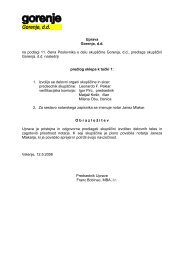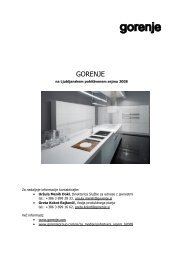Annual Report Gorenje Group 2009
Annual Report Gorenje Group 2009
Annual Report Gorenje Group 2009
You also want an ePaper? Increase the reach of your titles
YUMPU automatically turns print PDFs into web optimized ePapers that Google loves.
j) Non-current assets held for sale<br />
Non-current assets, or disposal groups comprising assets and liabilities, that are expected to be<br />
recovered primarily through sale rather than through continuing use, are classified as held for sale.<br />
Immediately before classification as held for sale, the assets, or components of a disposal group, are<br />
remeasured in accordance with the <strong>Group</strong>'s accounting policies. Thereafter generally the assets, or<br />
disposal group, are measured at the lower of their carrying amount and fair value less cost to sell. Any<br />
impairment loss on a disposal group first is allocated to goodwill, and then to remaining assets and<br />
liabilities on pro rata basis, except that no loss is allocated to inventories, financial assets, deferred tax<br />
assets, employee benefit assets, investment property, which continue to be measured in accordance<br />
with the <strong>Group</strong>'s accounting policies. Impairment losses on initial classification as held for sale and<br />
subsequent gains or losses on remeasurement are recognised in profit or loss. Gains are not<br />
recognised in excess of any cumulative impairment loss.<br />
k) Employee benefits<br />
(i) Short-term employee benefits<br />
Short-term employee benefit obligations are measured on an undiscounted basis and are expensed as<br />
the related service is provided.<br />
l) Provisions<br />
A provision is recognised if, as a result of a past event, the <strong>Group</strong> has a present legal or constructive<br />
obligation that can be estimated reliably, and it is probable that an outflow of economic benefits will be<br />
required to settle the obligation. Provisions are determined by discounting the expected future cash<br />
flows at a pre-tax rate that reflects current market assessments of the time value of money and the<br />
risks specific to the liability.<br />
(i) Warranties<br />
A provision for warranties is recognised when the underlying products or services are sold. The<br />
provision is based on historical warranty data and a weighting of all possible outcomes against their<br />
associated probabilities.<br />
A provision for warranties is reduced directly by costs for which it has been created. It means that such<br />
costs are no longer recorded in the income statement. At the end of the period for which provisions<br />
have been created, the unused portion of provisions is transferred to other operating income.<br />
(ii) Restructuring<br />
A provision for restructuring is recognised when the <strong>Group</strong> has approved a detailed and formal<br />
restructuring plan, and the restructuring either has commenced or has been announced publicly.<br />
Future operating losses are not provided for.<br />
(iii) Onerous contracts<br />
A provision for onerous contracts is recognised when the expected benefits to be derived by the <strong>Group</strong><br />
from a contract are lower than the unavoidable cost of meeting its obligations under the contract. The<br />
provision is measured at the present value of the lower of the expected cost of terminating the contract<br />
and the expected net cost of continuing with the contract. Before a provision is established, the <strong>Group</strong><br />
recognises any impairment loss on the assets associated with that contract.<br />
107<br />
<strong>Annual</strong> <strong>Report</strong> <strong>Gorenje</strong> <strong>Group</strong> <strong>2009</strong>

















